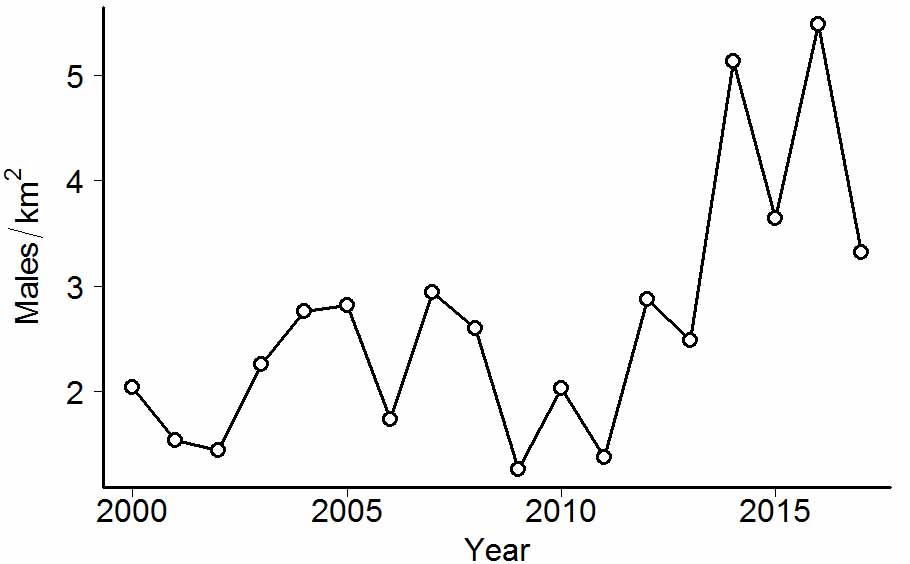The Svalbard rock ptarmigan (Lagopus muta hyperborea) is an endemic sub-species restricted to Svalbard and Franz Josef Land. They have an exceptional adaptation to high-arctic conditions in that they can put on fat (up to 350 g) as insulation and energy reserve from August to October. Their body size (up to 1200 g) is substantially larger than most other rock ptarmigan.
The population density of adults in the spring is relatively low and subjected to moderate temporal fluctuations. These fluctuations are at least partly driven by inter-annual variation in rain-on-snow (ROS) events that synchronize their population dynamics with sympatric Svalbard reindeer and sibling vole populations. To what extent biotic interactions in the very simple Svalbard food web also influence ptarmigan dynamics is unknown. However, predation (arctic fox) as well as direct and indirect (apparent) competition with reindeer and geese may play a role. Also limited habitat (<4% of the land area) and few food plant species likely make the Svalbard ptarmigan sensitive to fluctuations in plant production. The newborn ptarmigan chicks have a highly specialized diet of Bistorta vivipara bulbils. This may lead to phenological mismatch between ptarmigan reproduction and food plant growth.
Svalbard rock ptarmigan have been harvested for a long time and are presently the most popular small game around human settlements. Results from a shooting experiment indicate that they can be surprisingly resilient to harvesting but this may not be the case in a changing climate.

Development of the Svalbard rock ptarmigan population during the last 17 years. Estimates of male density are based on annual repeated point-transect surveys (see Monitoring methods) of territorial males during spring.
Expected climate impact
The impact of climate change on the Svalbard rock ptarmigan can be expected to be both direct and indirect and likely to be mediated by several pathways depicted in the conceptual model:
As a highly specialized forager in the breeding season, the Svalbard rock ptarmigan is likely to be particularly vulnerable to phenological mismatch with their preferred food plants under climate change. The prediction is that increased advanced onset of spring will lead to rapid phenological shifts in Bistorta vivipara, while the onset of reproduction in ptarmigan (i.e. egg laying) is predicted to be more conservative. Earlier springs are expected to reduce growth and survival of ptarmigan chicks due to reduced production and quality of Bistorta vivipara bulbils. The Svalbard rock ptarmigan is also likely to be affected by interspecific competition with the increasing populations of pink-footed geese through their intensive grazing and grubbing causing reduced plant biomass and habitat degradation. However, a warmer climate may also increase the primary productivity (biomass of forage plants) that may have a positive effect on the ptarmigan population.
A direct pathway is expected to be due to changes in the frequency of rain-on-snow (ROS) events. The effect of ROS has already been shown to have a negative impact on population growth rate derived from harvesting statistics. In addition, climate may have a direct effect on ptarmigan reproduction through variability in spring weather, that is expected to impact the onset of breeding and chick survival.
An indirect pathway is increased predation from the arctic fox. This negative impact results from increasing arctic fox populations due to climate and management related increased abundance of geese and reindeer mortality. Thus, this pathway is equivalent with the impact of generalist predator in the conceptual model for ptarmigan on the Varanger peninsula.

Expected effects of climate change and management decisions on the Svalbard rock ptarmigan in Svalbard. One impact is through changes in food availability with both positive and negative impact. Increased primary productivity (biomass) may have a positive impact. While negative impacts are either due to (1) reduced availability of food plants resulting from a phenological mismatch between ptarmigan reproduction and food plant growth (in particular bistorta bulbil production) or (2) removal and destruction of tundra vegetation by increasing populations of pink-footed geese. Another impact act directly through changes in frequency of extreme events through “rain-on-snow” impacting forage resources and survival, and spring weather variability affecting onset of breeding and chick survival. I final indirect impact pathway is through increasing arctic fox predation resulting from more ungulate carrion subsidies.
Management relevance
- Information about spring population densities of males is important to the Governor of Svalbard to provide advice on harvesting regulations whenever required. In the context of today’s rapid climate change, it is important to ensure that the harvesting level is sustainable in new climatic settings.
- Since the arctic fox is an important predator, both on eggs and adult ptarmigan, and increased predation may result from more reindeer carrion subsidies, the management on both arctic fox and Svalbard reindeer must be considered in the development of the Svalbard rock ptarmigan population.
- Since resource competition from increasing goose populations may impact the Svalbard rock ptarmigan negatively, management of geese should also be considered context of COAT Svalbard’s ptarmigan module.
Monitoring methods
Point-transects sampling data conducted by the Norwegian Polar Institute (MOSJ) since 2000 allows estimation of annual habitat occupancy and population density territorial males in spring. The monitoring area on Nordenskiöld Land is approximately 1200 km2 and includes Hanaskogdalen, Adventdalen with side valleys, DeGeerdalen, Eskerdalen and Sassendalen. Four fieldworkers on 4 snowmobiles survey up to 150 non-random and random survey points, separated by a minimum distance > 500 m, during 4 weeks in April. We observe for 15 min on each point.
In order to reduce the “footprint” of the ptarmigan population monitoring we intend to gradually replace the manual point transect monitoring with automatic acoustic recorders. The work to develop this new method was started in 2016 and is coordinated with the Varanger ptarmigan module.